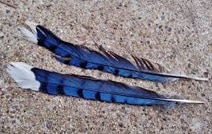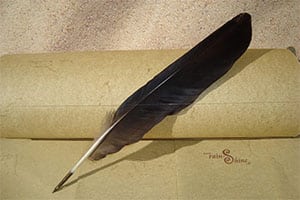 A feather is a horny structure that grows on the body of a bird . It consists of a tube (the cannon or calamus ) that is embedded in the skin and a protruding shaft , which has barbels .
A feather is a horny structure that grows on the body of a bird . It consists of a tube (the cannon or calamus ) that is embedded in the skin and a protruding shaft , which has barbels .
Feathers are appendages of the integumentary system , like horns or hairs in other species. These formations fulfill various functions: they protect against the cold, are insulating, serve for camouflage, are used during courtship and contribute to flight, for example.
The set of feathers of an animal is called plumage . Although each feather, individually, is very light, the plumage can weigh up to three times more than the skeleton .
It is important to mention that birds change their feathers through a process known as molting . Since the feathers deteriorate due to the presence of parasites, friction and other causes, the specimen sequentially sheds part or all of them and replaces them with other new feathers that grow in the same follicles .
In ancient times, the feathers of larger birds were used for writing . When the pen was introduced into an inkwell , the ink entered the hollow tube and then flowed by capillarity .
The term calamus not only refers to the hollow part of the animal feather, but is used synonymously with the writing instrument that we generally call a pen . Although the origin of calamus dates back to ancient Greece, there is a product with similar characteristics that had been created in Egypt. It was a type of brush that fell into disuse centuries before the calamus, although they coexisted for quite some time.
 To make a calamus without using a bird feather, you can use a hollow reed , which must be cut obliquely at one of its ends, which will rest on the inkwell and then on the leaf. Among the animals most used for making calamus were crows, swans, turkeys and ducks , birds that are mentioned in texts from the 6th century by the ecclesiastical scholar San Isidro of Seville . To keep the tip of the calamus sharp, it was cut again with some frequency.
To make a calamus without using a bird feather, you can use a hollow reed , which must be cut obliquely at one of its ends, which will rest on the inkwell and then on the leaf. Among the animals most used for making calamus were crows, swans, turkeys and ducks , birds that are mentioned in texts from the 6th century by the ecclesiastical scholar San Isidro of Seville . To keep the tip of the calamus sharp, it was cut again with some frequency.
All these products disappeared when the pen made of bronze, steel or other metals became popular, although the time in which this transition took place is unknown. Some point to the 15th century, while others claim that they already existed in the ancient Roman Empire.
By extension, today various writing instruments are called pens, such as the fountain pen ( pen ) and the atomic pen ( ballpoint pen ). Pen is also spoken of to refer to the ability or style of writing or as a synonym for writer : “This author is recognized for his satirical and sharp pen,” “Mario Vargas Llosa is among the best pens in the world,” “The pens “The most promising artists on the continent will come together in a new literary festival.”
In some Spanish-speaking regions, the term pluma can be used to refer to the effeminate attitude of a man. It is important to note that the nature of a remark of this type is not always offensive, but depends on several factors: who makes it, and whether he is also effeminate or homosexual ; In what context do you do it, whether in front of third parties or simply with your interlocutor; if you feel contempt for effeminate people. Saying that someone "shows his pen" means that "he cannot hide his homosexuality" , something that if not said with hatred or contempt can even be pleasant for the person who receives it.
